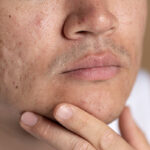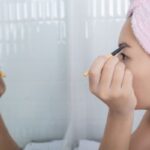What Is Tretinoin?
Tretinoin, also known as all-trans retinoic acid (ATRA), is a retinoid and a form of vitamin A that’s used to treat acne and other skin conditions. It works by increasing cell turnover and preventing the formation of comedones.
Comedones are those pesky whiteheads and blackheads caused by clogged pores.
Retinoids are a class of skincare active compounds derived from vitamin A having many beneficial effects on the skin, including decreasing wrinkles and improving skin tone, texture, and clarity. Retinoids can also help reduce acne and promote the production of collagen in the skin.
All of this means that tretinoin can make you look years younger in a matter of weeks! Plus, its anti-aging effects don’t just stop at the surface—it also helps stimulate cell growth deep into the skin to give you long-term results.
Tretinoin Benefits
Exploring the benefits of tretinoin for acne treatment could provide you with a potent remedy, harnessing its ability to unclog pores, reduce inflammation, and promote clearer, healthier skin.
Tretinoin is an incredible ingredient that can seriously improve the appearance of your skin. It’s one of those treatments that will have you looking like you just walked out of a salon in no time!
Not only does it increase collagen production, reduce wrinkles, and even out skin tone, but it also helps unclog pores, fight acne, and brighten overall skin complexion, Try tretinoin for acne treatment
Should You Use Tretinoin In Your Skincare?
Tretinoin is a versatile and powerful skincare ingredient that can help improve the appearance of your skin. Developed from Vitamin A, it has been used since the 1970s to treat acne and other skin conditions.
But can tretinoin also be used as part of an everyday skincare routine?
The answer is yes!
Tretinoin, when used in the right way, can make a huge difference in how your skin looks and feels. It can reduce wrinkles, fade dark spots and blemishes, even out skin tone, exfoliate dead skin cells, and increase collagen production for firmer, smoother skin.
Plus, it can help with acne, blackheads, and oiliness. Before you start using tretinoin, however, it’s important to consult a dermatologist or skin care specialist to make sure the product is right for your skin type and condition.
How To Use Tretinoin In Your Skincare Routine?
When it comes to skincare, Tretinoin is one of the most popular ingredients on the market. It’s known for its ability to reduce wrinkles and improve the appearance of sun-damaged skin, but it can also be used as part of your daily skincare routine.
Here’s how you can incorporate Tretinoin into your skin-care plan to get maximum results:
-
Start Slow
The best way to use Tretinoin is on a nightly basis. Depending on how your skin reacts, you can slowly increase the frequency of use over time. You may start by using it every other night and eventually move up to daily usage.
-
Cleanse-Apply-Moisturize
Start by cleansing your face with a gentle cleanser, then apply a thin layer of the product directly onto the affected areas. Allow it to absorb into your skin and leave it on overnight before rinsing with lukewarm water in the morning.
Follow up with a good slather of moisturizer if you’re experiencing dryness, irritation, or flakiness after using tretinoin. Choose an alcohol-free formula for best results and make sure to wait 20 minutes up to one hour before applying it so that your skin has time to properly absorb the product.
-
Protect
It’s important to note that Tretinoin can make your skin more sensitive to sunlight, so always remember to wear sunscreen when going outdoors the next day.
Wear sunscreen that is strong enough in the formulation and can protect your skin from harmful UV rays. Moreover, make sure to stay out of the direct sun as much as possible and avoid touching your face as much as possible.
Who Should Use Tretinoin?
Tretinoin is a prescription medicine that is FDA-approved to be used to treat severe acne and skin conditions and you can get tretinoin online from a good source which is available in the market.
To be an ideal candidate for retinoid/retinol treatment, one must have resilient skin. This means virtually no sensitivity whatsoever. It is suggested, to begin with, a readily available over-the-counter retinol product to see how your skin reacts before attempting Tretinoin – the latter doesn’t have to be your starting point.
If you’re apprehensive about introducing a more powerful retinol into your skincare routine, start with something milder. It’s also the ideal option for those dealing with indented acne scars, severe melasma, or hyperpigmentation.
Side Effects Of Tretinoin
One of the major drawbacks of tretinoin is its possible side effects. While it can be an effective solution for acne, wrinkles, and other skin issues, these potential side effects if persisted shouldn’t be taken lightly.
As you begin your tretinoin regimen, bear in mind that the initial stages of usage may cause further skin deterioration. To prevent side effects from happening, start with a lower tretinoin dosage and gradually increase it until desirable results are achieved. Here are the common side effects of using tretinoin or other retinoids:
- Dryness
- Purging
- Skin rashes
- Redness
- Stinging sensation
- Skin Peeling
Despite its notorious reputation, the tretinoin “purge” is a sign that your skin is acclimating to treatment and finding ways to heal itself. Don’t give up or turn away in fright; work through it!
Bottomline
Too much of any active ingredient can cause irritation or damage, so make sure to follow the instructions provided precisely. If used correctly, tretinoin can be a great addition to your skincare routine and make a big difference in the appearance of your skin.
Tretinoin can make huge help to reverse sun damage and erase signs of aging that have been compounded by age specifically if over 35, probably going to be your best bet!







